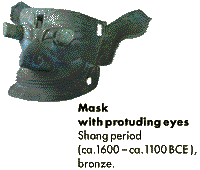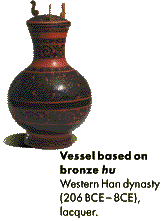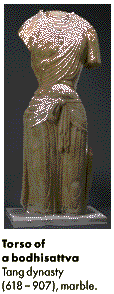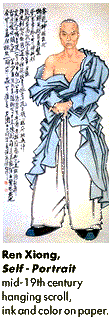 |
The traditional section of the exhibition explores the themes of innovation and transformation in seven major areas of artistic production: jade, bronze, grave goods, stoneware and porcelain, sculpture, painting, and calligraphy. Important examples of lacquer and textiles will also be on display. Earliest in date are Neolithic jades (ca.3600-ca.1700 BCE), worked with extraordinary precision to fashion images of great beauty and potency. Richly ornamented ritual bronzes embody the religious beliefs and practices of the Shang and Zhou dynasties (ca. 1600 BCE-256 BCE) and testify as well to the great technical achievements of bronze casters during that era. Low-fired tomb ceramics from the Qin and Han through the Tang periods (221 BCE- 907 CE) include lifelike effigies of animals and humans, deities and supernatural beings of all sorts, as well as intricate architectural models. A sequence of high-fired wares traces the development of porcelain from early times through the simple classicism of Song wares (960-1279) to the more ornamented and colorful styles of the Ming (1368-1644) and Qing (1644-1911) dynasties. The traditional section also includes a spectacular display of stone Buddhist sculpture. This presentation, unprecedented in America for a loan exhibition in its size and scope, offers a powerful example of the transforming force of Chinese culture, as it reveals foreign religious icons and styles being absorbed and modified into distinctly Chinese forms of expression. The uptown installation concludes with a selection of important paintings and calligraphy. Several rare survivals of early Song landscape painting are joined by important examples of Yuan dynasty (1279-1368) literati painting. Conservative works by court-sponsored and professional artists active during the Ming and Qing dynasties offer a sharp contrast to the sometimes radical experiments in both technique and expression of their individualist contemporaries, whose work continues to provide inspiration for modern Chinese painters. The modern section of the exhibition, on display at the Guggenheim Museum SoHo, is divided into four thematic sections that explore the meaning of modernity in Chinese art between 1850 and the present. Proceeding in roughly chronological order, they are: "Innovations in Chinese Painting (1840 - 1930)"; "The Modernist Generations (1920 - 1949)"; "Art for New China (1949 - 1979)"; "Transformations of Tradition (1965 - the present)". This section of the exhibition begins with painting developed under the patronage of Shanghai's new economic elite. Highlights include portraiture, works with bird and flower themes, as well as paintings featuring fantastic narratives that appealed to the collectors in this rising industrial port city. The exhibition goes on to explore the growing cosmopolitanism of Chinese artists, many of whom studied abroad between 1920 and 1949 and brought back trends from Japan, Europe, and the United States. This section of the exhibition will examine not only the introduction of oil painting to China but also the re-emergence of the woodcut as a powerful artistic medium, one suited to expressing concern over the economic and social upheavals of the first half of this century. The Chinese art world underwent a massive restructuring after the founding of the People's Republic of China in 1949. This period is represented by the large-scale socialist realist paintings that dominated the visual landscape of the era. Continuing with the spirit of innovation and transformation, the final part of the modern section of the exhibition will focus on the rejuvenation of traditional forms in the context of a growing globalism in the Chinese art world. |
|
 |
||
 |
||
 |
||